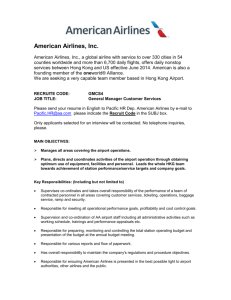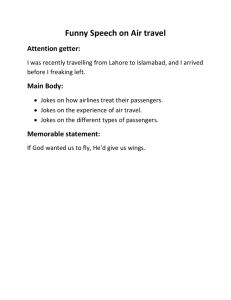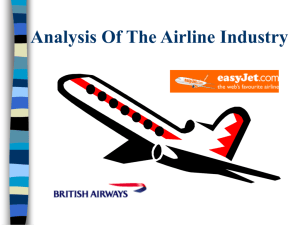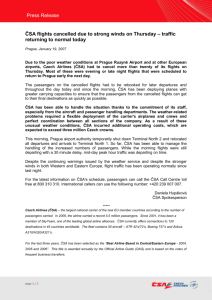–
advertisement
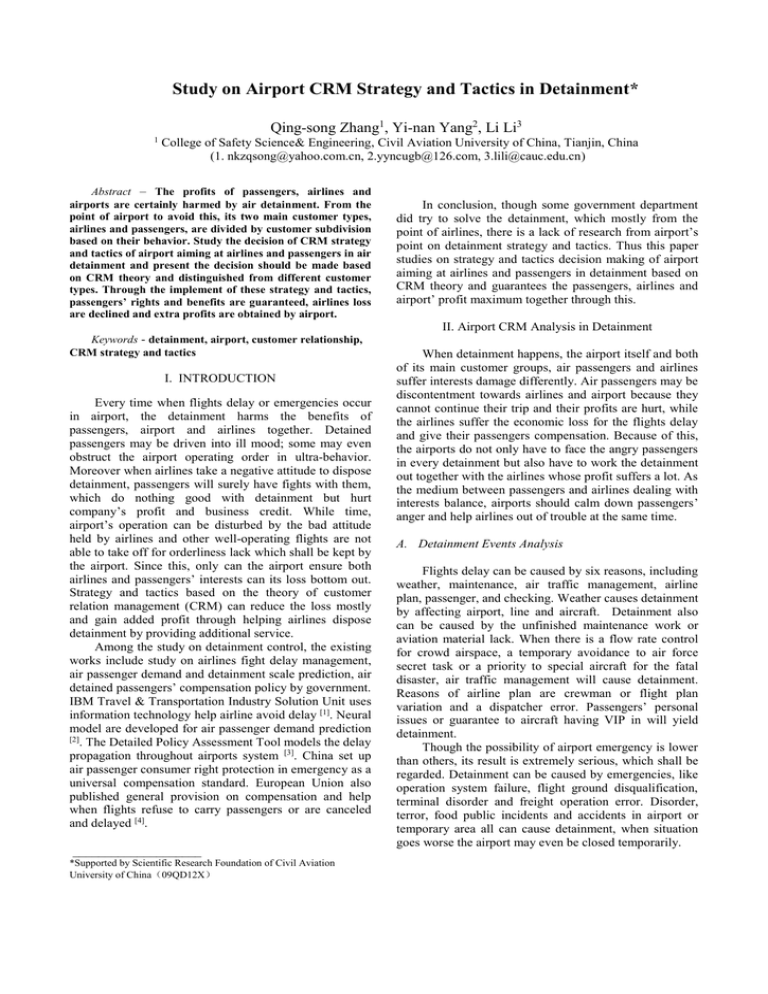
Study on Airport CRM Strategy and Tactics in Detainment* Qing-song Zhang1, Yi-nan Yang2, Li Li3 1 College of Safety Science& Engineering, Civil Aviation University of China, Tianjin, China (1. nkzqsong@yahoo.com.cn, 2.yyncugb@126.com, 3.lili@cauc.edu.cn) Abstract – The profits of passengers, airlines and airports are certainly harmed by air detainment. From the point of airport to avoid this, its two main customer types, airlines and passengers, are divided by customer subdivision based on their behavior. Study the decision of CRM strategy and tactics of airport aiming at airlines and passengers in air detainment and present the decision should be made based on CRM theory and distinguished from different customer types. Through the implement of these strategy and tactics, passengers’ rights and benefits are guaranteed, airlines loss are declined and extra profits are obtained by airport. In conclusion, though some government department did try to solve the detainment, which mostly from the point of airlines, there is a lack of research from airport’s point on detainment strategy and tactics. Thus this paper studies on strategy and tactics decision making of airport aiming at airlines and passengers in detainment based on CRM theory and guarantees the passengers, airlines and airport’ profit maximum together through this. II. Airport CRM Analysis in Detainment Keywords - detainment, airport, customer relationship, CRM strategy and tactics I. INTRODUCTION Every time when flights delay or emergencies occur in airport, the detainment harms the benefits of passengers, airport and airlines together. Detained passengers may be driven into ill mood; some may even obstruct the airport operating order in ultra-behavior. Moreover when airlines take a negative attitude to dispose detainment, passengers will surely have fights with them, which do nothing good with detainment but hurt company’s profit and business credit. While time, airport’s operation can be disturbed by the bad attitude held by airlines and other well-operating flights are not able to take off for orderliness lack which shall be kept by the airport. Since this, only can the airport ensure both airlines and passengers’ interests can its loss bottom out. Strategy and tactics based on the theory of customer relation management (CRM) can reduce the loss mostly and gain added profit through helping airlines dispose detainment by providing additional service. Among the study on detainment control, the existing works include study on airlines fight delay management, air passenger demand and detainment scale prediction, air detained passengers’ compensation policy by government. IBM Travel & Transportation Industry Solution Unit uses information technology help airline avoid delay [1]. Neural model are developed for air passenger demand prediction [2] . The Detailed Policy Assessment Tool models the delay propagation throughout airports system [3]. China set up air passenger consumer right protection in emergency as a universal compensation standard. European Union also published general provision on compensation and help when flights refuse to carry passengers or are canceled and delayed [4]. ____________________ *Supported by Scientific Research Foundation of Civil Aviation University of China(09QD12X) When detainment happens, the airport itself and both of its main customer groups, air passengers and airlines suffer interests damage differently. Air passengers may be discontentment towards airlines and airport because they cannot continue their trip and their profits are hurt, while the airlines suffer the economic loss for the flights delay and give their passengers compensation. Because of this, the airports do not only have to face the angry passengers in every detainment but also have to work the detainment out together with the airlines whose profit suffers a lot. As the medium between passengers and airlines dealing with interests balance, airports should calm down passengers’ anger and help airlines out of trouble at the same time. A. Detainment Events Analysis Flights delay can be caused by six reasons, including weather, maintenance, air traffic management, airline plan, passenger, and checking. Weather causes detainment by affecting airport, line and aircraft. Detainment also can be caused by the unfinished maintenance work or aviation material lack. When there is a flow rate control for crowd airspace, a temporary avoidance to air force secret task or a priority to special aircraft for the fatal disaster, air traffic management will cause detainment. Reasons of airline plan are crewman or flight plan variation and a dispatcher error. Passengers’ personal issues or guarantee to aircraft having VIP in will yield detainment. Though the possibility of airport emergency is lower than others, its result is extremely serious, which shall be regarded. Detainment can be caused by emergencies, like operation system failure, flight ground disqualification, terminal disorder and freight operation error. Disorder, terror, food public incidents and accidents in airport or temporary area all can cause detainment, when situation goes worse the airport may even be closed temporarily. B. Status and Problem of Airport Detainment Disposal Based on the national aviation low and international tradition and combined its actual situation, every airport establishes its own detainment plan, includes Abnormal Flight Scheme and Front Area Operation Procedure. Those are just focused on the special situation not aiming at general detainment treatment, the loss of economic and business reputation caused by the imperfection is common. On May 7th, 2010 vast flights delay in Guangzhou Airport caused over 20 events of passengers destroying the airport facilities. Even worse, in April, 2012 both of the extensive detainment in Guangzhou and Shanghai airport results in angry passengers obstructing flying-off aircraft. Therefore, the aviation administration informs the disposal of these accidents to all the aviation units and suspends involved flight’s operation for the improper disposal of the longtime detainment taken by Shenzhen Airline. Among the above accidents, airport’s loss is mainly caused by improper disposal of relation among passengers, airlines and airport. To improve status, the airport should bring in CRM theory and deal its customer relationship in detainment scientifically. The problems in implement of CRM for airport detainment disposal are as follow. (1) Just take CRM as work software, do not combine the CRM ideology with detainment disposal. That is to say the customer, the most important resource are not satisfied by customer analysis and service. (2) Ignore that the supreme goal is achieving profit maximum but not just fulfill the customers’ need simply. That is implement CRM don’t just aim on helping airlines decline their loss or fulfill the customers but on achieving profit maximum. opinion, whether customer would buy more products and service is depended on their behavior [6]. Many firms have adopted customer subdivision according to the attribute of customer behavior, for example airlines divide customers depending on their flights mileage into platinum customer, gold customer and silver customer. So airport detainment CRM should be constituted by the customer subdivision of customer behavior on passengers and airlines, the CRM strategy establishment varying different customer groups and CRM tactics implement. A. Airlines Customer Subdivision of Behavior Analysis Through the investigation on the passengers’ view to airlines, detainment disposal patterns taken by airlines can be divided into these types thereinafter. (1)Extensive Form Care nothing for the detainment instance and reject all their questioning and requiring. (2)Stylization Form Dispose the detainment stylized, walk through passengers’ asking and excuse themselves from passengers’ need. (3)Active Form Regard passengers’ need, cooperate with air traffic management unit and airport, inform state process and satisfy passengers’ rational needs. Airlines customer types’ matrix chart (fig. 1.) shows 9 customer groups, which arrange each group with matrix compositor method as AiBk. Abscissa is the efficiency of airlines detainment disposal while y-axis is detainment time extent (degree of detainment). The darkness of every module’s color represents airport’s participation extent, like must, need and may. C. Goals of Implement CRM for Airport Detainment Combine the detainment disposal’s ideology with the CRM theory. Obtain the types of passengers and airlines through customer subdivision and make different CRM strategy and tactics varying different types. Provide extra service to airlines of detainment, replace the airlines to serve and comfort passengers and help them decline loss but gain airport’s profit at the same time. Though at the forepart of implement CRM the profit is negative, the speed of attract client is fast enough to reach the balance point in a very short time and in a long term afterwards CRM can bring in a continual and steady profit for the airport[5]. Consequently goals for implement CRM of airport detainment shall include setting up CRM strategy for achieving profit maximum, putting in CRM tactics based on customer subdivision on their behavior, and establishing proper CRM system and structure. III. Detained Passengers Behavior Study It is easy to study customer subdivision by statistics character, while it is hard to reflect the customers’ need or relationship and guide the corporation to fulfill customer and achieve profit maximum. In Frederick Reichheld’s Fig. 1. Airlines customer types’ matrix chart B. Passengers Customer Subdivision Based on Behavior To comprehend air detained passengers’ behavior, we use questionnaire to do research. The questionnaire is designed according to the passengers’ need, investigating under 5 kinds of detainment time extent their collectivity behavior trend as follow, which based on Demand Phase theory and safety psychology [7]. (1) Physiological Need. (2) Respect Need [8]. (3) Do things what others do effected by fluster [9]. (4) Detainment time. (5) Passengers scheduling. (6) Awareness of aviation industry. (7) Passengers’ character. (8) Nearby environment [10]. The 14 passengers’ behavior modes are divided into 5 levels by how the passengers reacting to detainment. Details are in the follow table. TABLE I Level 1 2 3 4 5 14 categories of passengers’ behaviors Behavior Description Understand Just 1.1 1.2 1.3 Flow others and Waiting Unsatisfied 2.1 Know the Detainment Reason and Waiting Tim 3.1 Restroom 3.2 Free Food 4.1 Change 4.2 Cancel 4.3 Complain to Superior 4.4 Compensation 4.5 Must Send Me to Destination Argue With Demonstrate No More Bear 5.1 5.2 5.3 Staff and Protest React Fiercely 200 questionnaires were sent out and 195 receded by field survey in airports, professional forum research and online survey during March to May, 2010. Through the investigation detainment time is found as first factor of passengers’ behavior, combined with the results passenger customer types’ matrix chart are obtained (fig. 2.). IV. Airport CRM Strategy and Tactics in Detainment Survey shows nearly 90% interviewees had been in detainment often or once, over 60% have no awareness of detainment fact, acceptable detainment time is within 90 minutes, over 90% were ever harmed and one quarter was harmed seriously, 60% were unsatisfied with the airport measures while over 80% think government effort make difference to detainment. Above results make it exigent for airport to take own advantages, ensure passengers and airlines’ interest, decline its own loss and achieve profit maximum under CRM theory in detainment. Since this, in detainment airport should make CRM strategy of airlines to help control state and decline loss while execute CRM tactics of detained passengers to comfort their emotion, ensure their rights and profits, help them reach agreement with airlines and continue their trip. A. CRM Strategy of Airlines in Detainment CRM strategy of airlines in detainment should lean on providing extra service scheme (fig. 3.) to airlines, which vary different customer groups. By executing CRM tactics of detained passengers, the goals of implement CRM for airport detainment are achieved. Fig. 2. Passenger customer types’ matrix chart Fig. 3. CRM service scheme of different airlines customer groups 25 customer groups are arranged with matrix ranking method as AiBk, abscissa represent passenger behavior extent while y-axis is detainment time extent (degree of detainment), and the darkness of every module’s color is first three behavior level in each detainment time extent. (1)Detained within 30 minutes, most passengers concentrate on Level 1, 2 and 3. Whether passengers who understand this detainment or not react as waiting in peace. (2)Detained for 60 minutes, more passengers want to ‘Know detainment reason and waiting time’; while time passengers need ‘Restroom and free food’ get big increase. (3)Detained for 90 minutes is a turning point. Over half passengers transmit to choose Level 3, while people choose Level 4 and 5 increase steadily from 20% to 40%. (4)Detained for 120 minutes, behavior trend turns to Level 3 and 4, which is 2/3 passengers’ choices. (5)Detained over 120minutes is beyond everyone’s patience limit. There is a big increase of people cancelling flight, over 30% thinking must send them to destination, 20% in Level 3 and only 20% people in Level 1 and 2. Take strategy of cost control to minitype airlines, like provide consulting service to decline this cost part as much as possible. Transfer the un-payoff state of this customer group to payoff state and commend choosing extra service scheme to keep the potential customer. Take strategy of participation to medium-sized airlines, like provide proper extra service scheme to extensive and stylization form to choose. Devote most resource of detainment disposal to this group and increase the airport’s payoff level of them in product return term. Take strategy of cooperation to active airlines. Fulfill their demand as much as possible. Maintain and develop this customer group. B. CRM Tactics of Passengers in Detainment The CRM tactics of passengers must depend on different detainment time. The CRM tactics schemes for airlines can be achieved through strengthen corresponding CRM tactics measures to passengers’ behavior trend in different detainment time (fig. 4.). Since detainment time beyond acceptance and over half on Level 4, strengthen transaction and appellation. In former hour inform time every 30-minute and send leaflet, cut the interval to every 15-minute and change leaflet to literature. Add the security department into comfort and contact police station every 15-minute. Moreover, change comfort teams every 30-minute to avoid work burnout. V. Conclusions Fig. 3.Relationship Between Behavior Levels And Measure Levels i. Measures on Within 30 minutes Passenger behavior trend is Level 2, so staff should inform detainment reason and waiting time firstly then arrange restroom. For 10% choose change or cancel, staff should transact as usual. Watch anger in case of accident. ii. Measures on Within 60 minutes Since trends still on Level 2 but Level 3 increasing simultaneously, staff should afford detainment reason, time and food. While people on Level 4 increasing to 20%, service windows and comfort staff should be added and leaflet on aviation knowledge should be served around passengers. Still watch anger in case of accident. iii. Measures on Within 90 minutes Since over half on Level 3, staff must inform reason and time every 30-minute and after one hour every 15minute. Then afford restroom and food. For Level 4 and 5 increasing to 40%, service windows and comfort staff should be added and leaflet on aviation knowledge should be sent to passengers. Watch anger in case of accident and contact police station every 15-minute. Moreover, change comfort teams every 30-minute to avoid work burnout. iv. Measures on Within 120 minutes Since passengers getting tired, 2/3 is on Level 3 and 4. Restroom and food are must. In former hour inform waiting time every 30-minute and send leaflet, in the left time cut the interval to every 15-minute and change leaflet to literature. Add security department into comfort and contact police station every 15-minute. Moreover, change comfort teams every 30-minute to avoid work burnout. v. Measures on Over 120 minutes The issues of passengers detained in airport caused by emergencies happen constantly and harm passengers, airlines and airports’ profit together. Since this, this paper subdivides airports’ main customer through the survey of passengers and airlines’ behavior in detainment, brings CRM theory into detainment disposal for airport, makes proper CRM strategy and tactics, and ensure passengers installed appropriately, decline airlines’ loss and keep airport orderliness. The main conclusions are as follow. (1)Since airlines’ detainment disposal varies, CRM strategy of airlines should be established depending on their behavior. Under this strategy’s guidance, airport can help them disposal detainment and serve passengers by providing extra service and achieve profit maximum. (2)Detained passengers’ behavior varies from time, so their tactics should be set up according to both their behavior and behavior trend in different time. (3)Bring CRM theory into airport detainment disposal can ensure passengers’ rights and profits, decline airlines’ loss and achieve the airport’s profit maximum. REFERENCES [1] D.J. Medeiros, E.F. Watson, J.S. Carson and M.S. Manivannan, eds. Avoiding the blues for airline travelers[C], Proceedings of the I998 Winter Simulation Conference, 1998: 1111-1112. [2] K.P.G. Alekseev, J.M. Seixas, Forecasting the air transport demand for passengers with neural modeling[C], Proceedings of the VII Brazilian Symposium on Neural Networks (SBRN*ˉ02), 2002: 301-326. [3] Lisa Schaefer, David Millner, Flight delay propagation analysis with the detailed policy[C], 2001, 1301-1303. [4] Yun PING, Early-warning management system research on aviation airport safety [D], Wuhan University of Technology, 2003, P55-56. [5] Hui SHAO, WANG Kai-quan, Safety psychology [M], Beijing: Chemical Industry Press, 2004: 31-33. [6] Frederick F. Reichheld, The Loyalty Effect: The hidden force behind growth, profits, and lasting value, Boston, Massachusetts, Harvard Business School Press, 1996: 1300. [7] Lan YU, Mass event caused by flights delayed and control [J], Air Transport & Business, 2009, 244(9) , 19-46. [8] Jing-yi AN, Study on collective behavior under public emergencies [D], Heilongjiang: Heilongjiang University, 2010, 11-13. [9] Yi-feng JIN, Waiting behavior psychology and environment amelioration in waiting room [J], Journal of Shenyang Jianzhu University (Natural Science), 1992, (1), 50-52. [10] Hui Tian, The research of airline customer relationship management model [D], Shanghai Transportation University, 2008, 17-19.

